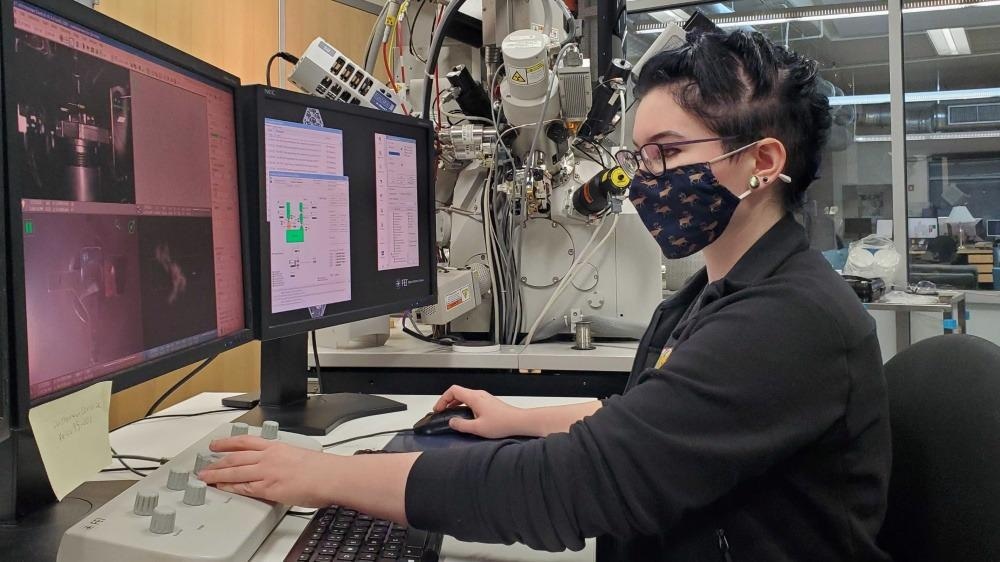University of Oregon (UO) chemist Carl Brozek’s lab has managed to create an adaptable kind of tiny porous material termed a metal-organic framework (MOF) into nanocrystals — a form that is much simpler to use outside the lab.

Image Credit: University of Oregon.
Nanoparticles such as these have a variety of possible applications, from surface coatings that can trap electric charge, to filters that eliminate pollutants from air or water.
The nanocrystals are the tiniest and steadiest MOFs created thus far, said Brozek. Moreover, they have a range of fascinating properties — particularly, they can conduct electricity, and they act differently subject to the exact size of the particle.
It really feels like we’ve cracked into something new.
Carl Brozek, Study Lead and Chemist, University of Oregon
He and his team, led by graduate student Checkers Marshall, published their research article in the November 24th pre-print issue posted to the research site ChemRxiv.
MOFs can be defined as sponge-like materials composed of metal ions, such as zinc or iron, connected together with tiny carbon-based molecules. Similar to a holey chunk of Swiss cheese, MOFs have crevices and pockets that give them a very high surface area.
This renders them beneficial for applications that require capturing precise molecules, such as carbon dioxide from the air or lead in drinking water because there is plenty of space for those target molecules to stick on.
Furthermore, forming them in nano-sized would be very practical for scaling up and using in the industry because the tiny particles could be suspended in a solution and then, like paint, used to uniformly coat a surface.
But the manufacture of MOFs as nanoparticles has been a constant challenge, Brozek said.
Therefore, his lab formulated a workaround. “As the MOF tries to grow, we trick it,” he said.
MOFs develop via a string of chemical reactions that combine metal ions with linker molecules. Brozek’s team incorporated a third ingredient: molecules that imitate the linkers, but that can only stick to something on one end. Similar to edge pieces on a jigsaw puzzle, they behave like dead-ends for the growing MOF, ensuring it remains small.
One of the really exciting things about our paper is, not only did we make this particular MOF as a nanocrystal, it’s also one of the smallest MOFs that’s ever been made.
Carl Brozek, Study Lead and Chemist, University of Oregon
These nanoparticles, composed of iron triazolate, are versatile: they act differently at various sizes and even at various temperatures. That makes way for a range of opportunities, Brozek said — researchers could “tune” the materials to act a specific way, by modifying the temperature of the environment or the size of the nanoparticles.
They could use an analogous method to engineer other MOF nanocrystals with diverse combinations of metal ions and linker molecules.
“The work is pretty fundamental right now,” Marshall said. “I think the most important things are that we're capable of synthesizing these nanoparticles and they show size-dependent properties that haven't been observed before. These two developments will help adapt how we apply MOFs in existing devices as well as harness their size-dependence in future technologies.”
Brozek and his team are already looking for probable applications, both for iron triazolate nanoparticles and other variations.
“Now that we can make a film out of these materials, there’s a real possibility that we’d be able to make membranes that are useful in the real world,” Brozek said.
For instance, MOF nanoparticles coating a surface could stick to carbon dioxide molecules that would otherwise be emitted into the air. Or the particles could be designed to adhere to pollutants in water.
This is just one MOF. It’s going to take lots of labs to explore this whole new field of science.
Carl Brozek, Study Lead and Chemist, University of Oregon
Journal Reference:
Marshall, C., et al. (2021) Size-Dependent Properties of Solution-Processable Conductive MOF Nanocrystals. ChemRxiv. doi.org/10.26434/chemrxiv-2021-cxxlq.